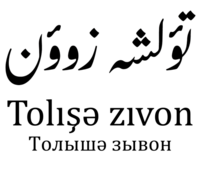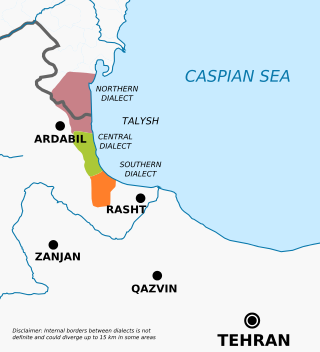
Back اللغة الطالشية Arabic Idioma talysh AST Talış dili Azerbaijani تالیش دیلی AZB Талишки език Bulgarian Talicheg Breton Talixi Catalan Талишийн мотт CE زمانی تاڵشی CKB Талыш чĕлхи CV
| Talysh | |
|---|---|
| Tolışə zıvon Tолышә зывон تؤلشه زوؤن | |
 Talysh written in Nastaliq script (تؤلشه زوؤن), Latin script (Tolışə zıvon), and Cyrillic script (Tолышә зывон) | |
| Native to | Iran Azerbaijan |
| Region | Western and Southwestern Caspian Sea coastal strip |
| Ethnicity | Talysh |
Native speakers | 229,590[1] |
| Arabic script (Persian alphabet) in Iran Latin script in Azerbaijan Cyrillic script in Russia | |
| Official status | |
| Regulated by | Academy of Persian Language and Literature[citation needed] |
| Language codes | |
| ISO 639-3 | tly |
| Glottolog | taly1247 |
| ELP | Talysh |
| Linguasphere | 58-AAC-ed |
 | |
 Talysh is classified as Vulnerable by the UNESCO Atlas of the World's Languages in Danger | |
Talysh (تؤلشه زوؤن, Tolışə Zıvon, Tолышә зывон)[3][4] is a Northwestern Iranian language spoken in the northern regions of the Iranian provinces of Gilan and Ardabil and the southern regions of the Republic of Azerbaijan by around 500,000-800,000 people. Talysh language is closely related to the Tati language. It includes many dialects usually divided into three main clusters: Northern (in Azerbaijan and Iran), Central (Iran) and Southern (Iran). Talysh is partially, but not fully, intelligible with Persian. Talysh is classified as "vulnerable" by UNESCO's Atlas of the World's Languages in Danger.[5]
- ^ "Talysh". Ethnologue. Archived from the original on 9 March 2023. Retrieved 30 March 2023.
- ^ کلباسی, ایران [in Persian]. شباهتها و تفاوتهای تالشی، گیلکي و مازندرانی [Similarities and differences between Talysh, Gilaki and Mazandarani]. زبان شناسی [Linguistics] (in Persian). 20 (1): 58–97. Archived from the original on 26 March 2022. Retrieved 9 July 2020.
- ^ Cite error: The named reference
pirejkowas invoked but never defined (see the help page). - ^ Məmmədov, Novruzəli; Ağayev, Şahrza (1996). Əlifba — Tolışi əlifba. Baku: Maarif.
- ^ "Talysh". UNESCO Atlas of the World's Languages in danger. UNESCO. Archived from the original on 15 October 2022. Retrieved 3 August 2018.